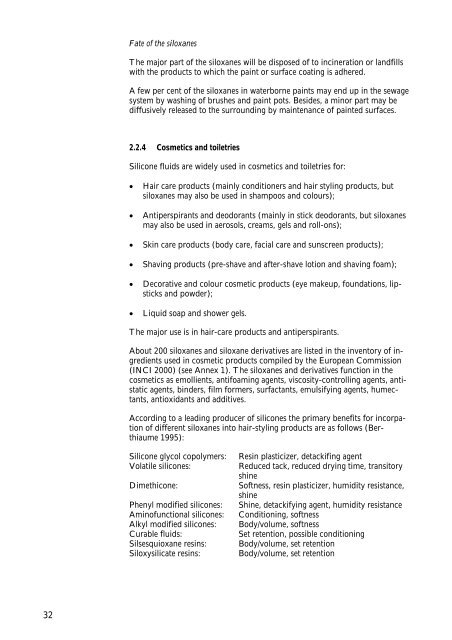Siloxanes - Consumption, Toxicity and Alternatives - Miljøstyrelsen
Siloxanes - Consumption, Toxicity and Alternatives - Miljøstyrelsen
Siloxanes - Consumption, Toxicity and Alternatives - Miljøstyrelsen
You also want an ePaper? Increase the reach of your titles
YUMPU automatically turns print PDFs into web optimized ePapers that Google loves.
32<br />
Fate of the siloxanes<br />
The major part of the siloxanes will be disposed of to incineration or l<strong>and</strong>fills<br />
with the products to which the paint or surface coating is adhered.<br />
A few per cent of the siloxanes in waterborne paints may end up in the sewage<br />
system by washing of brushes <strong>and</strong> paint pots. Besides, a minor part may be<br />
diffusively released to the surrounding by maintenance of painted surfaces.<br />
2.2.4 Cosmetics <strong>and</strong> toiletries<br />
Silicone fluids are widely used in cosmetics <strong>and</strong> toiletries for:<br />
• Hair care products (mainly conditioners <strong>and</strong> hair styling products, but<br />
siloxanes may also be used in shampoos <strong>and</strong> colours);<br />
• Antiperspirants <strong>and</strong> deodorants (mainly in stick deodorants, but siloxanes<br />
may also be used in aerosols, creams, gels <strong>and</strong> roll-ons);<br />
• Skin care products (body care, facial care <strong>and</strong> sunscreen products);<br />
• Shaving products (pre-shave <strong>and</strong> after-shave lotion <strong>and</strong> shaving foam);<br />
• Decorative <strong>and</strong> colour cosmetic products (eye makeup, foundations, lipsticks<br />
<strong>and</strong> powder);<br />
• Liquid soap <strong>and</strong> shower gels.<br />
The major use is in hair-care products <strong>and</strong> antiperspirants.<br />
About 200 siloxanes <strong>and</strong> siloxane derivatives are listed in the inventory of ingredients<br />
used in cosmetic products compiled by the European Commission<br />
(INCI 2000) (see Annex 1). The siloxanes <strong>and</strong> derivatives function in the<br />
cosmetics as emollients, antifoaming agents, viscosity-controlling agents, antistatic<br />
agents, binders, film formers, surfactants, emulsifying agents, humectants,<br />
antioxidants <strong>and</strong> additives.<br />
According to a leading producer of silicones the primary benefits for incorpation<br />
of different siloxanes into hair-styling products are as follows (Berthiaume<br />
1995):<br />
Silicone glycol copolymers: Resin plasticizer, detackifing agent<br />
Volatile silicones: Reduced tack, reduced drying time, transitory<br />
shine<br />
Dimethicone: Softness, resin plasticizer, humidity resistance,<br />
shine<br />
Phenyl modified silicones: Shine, detackifying agent, humidity resistance<br />
Aminofunctional silicones: Conditioning, softness<br />
Alkyl modified silicones: Body/volume, softness<br />
Curable fluids: Set retention, possible conditioning<br />
Silsesquioxane resins: Body/volume, set retention<br />
Siloxysilicate resins: Body/volume, set retention

















